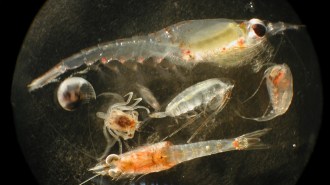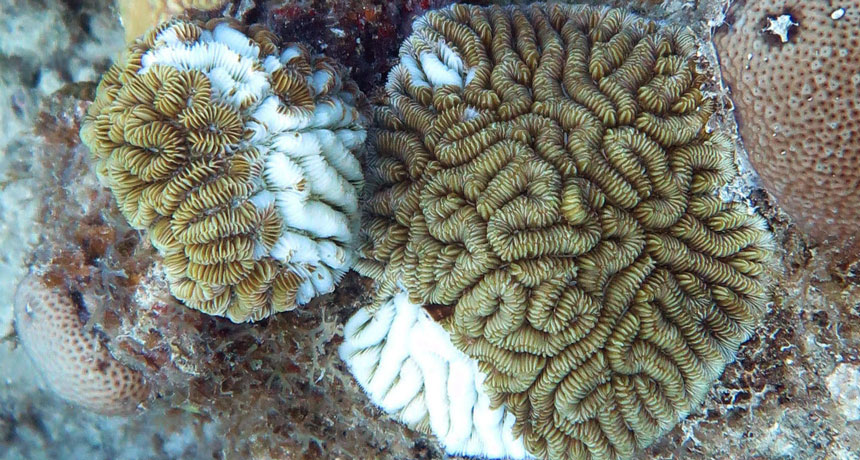
CORAL KILLER Lesions (white) eat into the tissue of maze corals on Flat Cay reef, near St. Thomas in the U.S. Virgin Islands. The lesions are caused by a new and deadly disease that’s spreading through the Caribbean.
M. Brandt
- More than 2 years ago
Divers monitoring coral reefs off St. Thomas in the U.S. Virgin Islands in January noticed something alarming: Big white lesions were eating into the colorful tissues of hundreds of stony corals. Some corals were dead by the next day — only their stark white skeletons remained. Others languished for up to two weeks. Within four months, more than half of the reef suffered the same demise.
What’s killing the corals is far from clear, but the prime suspect is stony coral tissue loss disease, sometimes referred to by its initials SCTLD or by the nickname “skittle-D.” This infection, discovered off Florida in 2014, is responsible for what some scientists consider one of the deadliest coral disease outbreaks on record.
In the Caribbean, the disease is now ravaging about a third of the region’s 65 reef-building species, scientists estimate. Yet researchers aren’t even sure if the disease is viral, bacterial or some other microbial mix. Whatever the cause, “it’s annihilating whole species,” says coral ecologist Marilyn Brandt, who is leading a science team trying to tackle the outbreak from multiple research angles.
Past outbreaks of other coral diseases near St. Thomas have cut coral cover by up to 50 percent over a year, says Brandt, of the University of the Virgin Islands. But this new disease has done the same amount of damage in half that time — spreading faster and killing more corals than any past outbreaks in the area.
“It marches along the reef and rarely leaves corals behind,” Brandt says. “We’re pretty scared.”
Melt away
Stony coral tissue loss disease can kill corals in a matter of days or weeks. Here, a lesion eats away at coral tissue over six weeks.

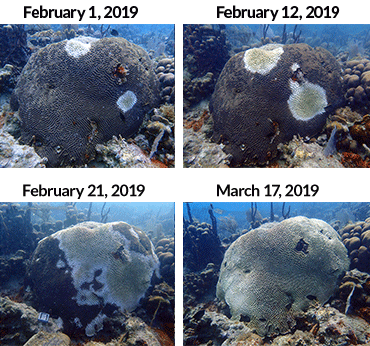
A disease hot spot
Coral reefs occupy less than 2 percent of the ocean floor. But they play a crucial role in the ecosystem, sustaining an estimated quarter of marine species. Sometimes mistaken for rocks or plants, corals are actually collectives of coral polyps, tiny invertebrates that get sick just like any other animal. Corals sometimes succumb to deadly plagues. Other times, they can shake off milder maladies akin to a common cold.
Since the first coral disease was documented in the 1970s in the Caribbean, researchers have identified dozens more around the world, with the Caribbean now considered a coral disease hot spot. But scientists still know little about these illnesses and how they work. Many marine microbes don’t grow well in petri dishes and test tubes, so studying coral diseases is tough, Brandt says.
Even the names given to the diseases are vague, based only on the visual cues of an infection, such as yellow-band disease, dark-spot syndrome and white plague. And it doesn’t help that many look similar. Stony coral tissue loss disease, which first attacks brain corals before moving on to other stony corals, was initially mistaken for white plague.
Performing reef triage
Off southeast Florida, the outbreak has persisted for five years. In that time, the disease has affected almost all of a 580-kilometer stretch of reef, including the Florida Keys, says marine biologist Karen Neely of Nova Southeastern University in Fort Lauderdale, Fla. Such a prolonged assault surprised scientists. Coral disease outbreaks typically burn out after a few months.
Hit list
Stony coral tissue loss disease appeared off Florida in 2014 and has since spread across the Caribbean. Cases of the disease have been confirmed (red) on reefs off Mexico, Jamaica, St. Maarten, the Dominican Republic and St. Thomas in the U.S. Virgin Islands. Suspected cases are shown in orange.
Mapping cases of stony coral tissue loss disease
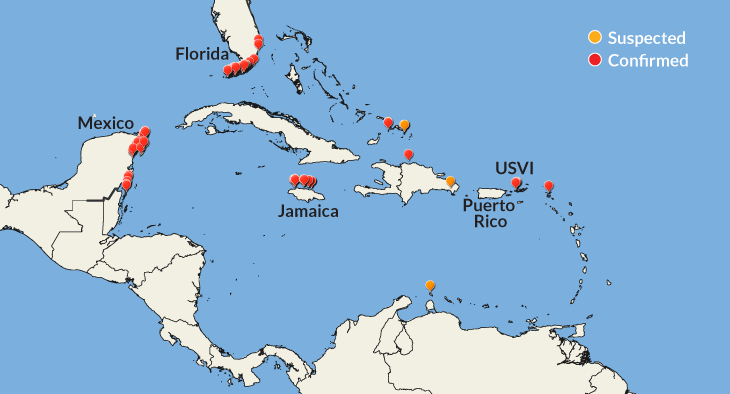
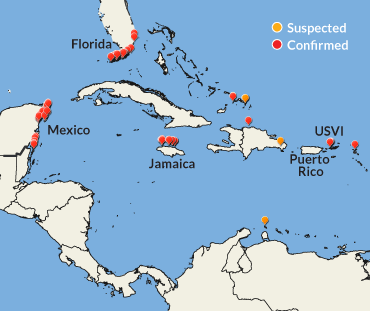
Source: P.R. Kramer, L. Roth and J. Lang/AGRRA 2019 (Data source: AGRRA)
Neely and others are trying to save Florida’s reef-building corals by moving hundreds of healthy colonies to tanks, where they can be studied, bred and protected from the outbreak along the coast. Meanwhile, divers slather sick corals left in the reef with a disinfectant and an amoxicillin paste, which seems to heal lesions. Neely estimates that Florida researchers have treated nearly 1,200 colonies since January.
With the antibiotic, “we are seeing about 85 percent success,” Neely says. But the medicine doesn’t stop new lesions from popping up. “One of the big priorities is to develop colony level treatments,” she says. Until then, this paste “is the best we can hope for.”
The antibiotic’s effectiveness suggests the disease could be bacterial, Brandt says. But the disease could have viral origins, in which case the paste would be treating a symptom, not the cause.
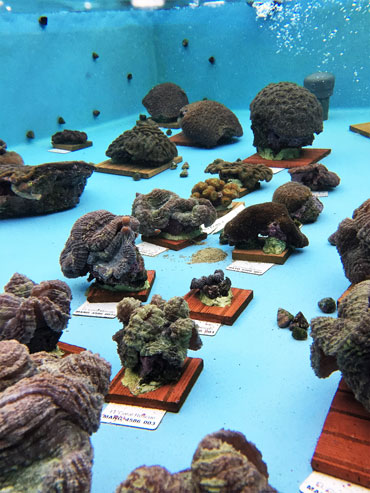
Hunting a coral killer
To find out what might be causing the disease, members of Brandt’s team are looking at corals’ microbiomes — the multitudes of microbes that live in and around corals. Building the list of suspects requires first sorting out what normally belongs on healthy corals, and what doesn’t.
At Woods Hole Oceanographic Institution in Massachusetts, marine ecologist Amy Apprill and colleagues are scrutinizing the microbiomes of sick corals, as well as sediments and water circulating around the reefs in St. Thomas. Comparing that data with data from Florida corals may uncover similarities between the two outbreaks that can help narrow the list of culprits, Apprill says.
The team is also focusing its microscopes on samples of brain and star corals taken just as lesions popped up. Originally from a healthy reef in St. Thomas, the corals caught the disease during an experiment in which they were placed near infected corals from Flat Cay in an aquarium. “We might be getting a look at what ‘early’ disease looks like,” Apprill says, before opportunistic microbes gain a foothold.
She doesn’t expect to find a singular pathogen, though. “Many scientists are moving toward this idea that it may be a consortium” of microbes that causes a disease, she says. And that consortium could look different for different coral species and in different environments. But a disease might trigger similar shifts in microbial diversity, so those patterns are something to watch for, Apprill says.
New clues about stony coral tissue loss disease are coming from a research team in Florida led by Julie Meyer of the University of Florida in Gainesville. That team found that diseased corals had microbiomes that were more prone to change and become more diverse than their healthy counterparts. Genetic analyses of these microbiomes identified five types of bacteria abundant in corals infected with the disease, the researchers report May 3 at bioRxiv.org. At least one type thrives in low-oxygen conditions that accompany decaying tissue, and all have been linked to other coral disease outbreaks around the world.
But more work is needed to determine if the microbes identified are causing the disease, or simply taking advantage of an opportunity to populate the weakened coral.
Profiling the victims
While some researchers hunt for pathogen suspects, coral immunologist Laura Mydlarz and others are investigating what happens to sickened corals at the cellular level. “I’m more on the host side,” trying to figure out why some hard coral species are more vulnerable than others, says Mydlarz, who is part of Brandt’s team.
Mydlarz’s lab, at the University of Texas at Arlington, has shown that the immune systems of some susceptible coral species get stuck in cell-death mode, or apoptosis, when tricked into thinking that pathogenic bacteria are invading. These corals slough off their tissue. Species that are more disease-tolerant, however, had immune systems that went into cell-recycling mode and fought off infection, her team reported in Proceedings of the Royal Society B in 2017.
Mydlarz suspects something similar might be happening in corals vulnerable to stony coral tissue loss disease. That’s because the species in her study that favored cell-death mode are among those hit hardest by the outbreak.
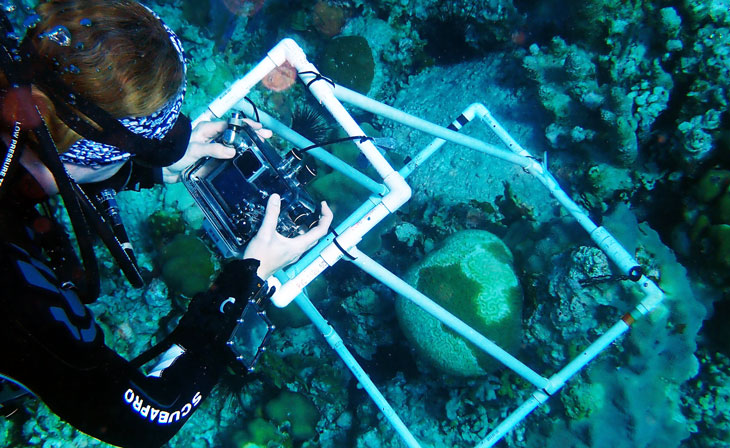
Waters getting warmer
This race to learn more about stony coral tissue loss disease and other infections is becoming urgent as climate change warms ocean waters. Global warming is like a one-two punch for coral disease: Heat stress and bleaching may weaken coral defenses, while warming waters send pathogens into overdrive. Pollution, overfishing and other environmental factors can also stress corals, giving pathogens an in.
“Coral reefs just can’t catch a break,” Brandt says. “I feel like we’re playing whack-a-mole,” addressing one challenge after another.
Oceans are now warming 40 percent faster than what had been predicted in the 2014 report by the U.N. Intergovernmental Panel on Climate Change, according to an analysis published in January in Science. And the trend is expected to continue, as oceans soak up roughly 93 percent of excess atmospheric heat trapped by greenhouse gases.
As ocean temperatures rise, coral disease will likely rival bleaching as a major driver of coral decline. Disease outbreaks are expected to become more frequent and more severe, researchers reported in 2015 in Nature Climate Change.
Flat Cay reef off St. Thomas had been considered resilient, having rebounded from a major bleaching event in 2005 and back-to-back hurricanes in 2017. But the current outbreak has killed off all of the reef’s maze corals, a type of brain coral. And pillar corals could be next, Brandt says. Stony coral tissue loss disease “seems to be capable of changing the face of coral reefs as we know it.”
A disease on the move
The researchers are trying to keep up with where and how the disease is spreading. Pathogens may have made their way from Florida to St. Thomas in the ballast water of ships, says coral reef ecologist Dan Holstein of Louisiana State University in Baton Rouge. Stony coral tissue loss disease has also been reported on reefs off the east coast of Mexico, Jamaica, St. Maarten and the Dominican Republic.
Holstein is using ocean current data and other factors to forecast where the disease might show up next. Early results suggest that another U.S. Caribbean territory, Puerto Rico, should be worried. Divers in May confirmed that the outbreak is inching toward the Puerto Rican island of Vieques, with star corals about 17 kilometers offshore and 40 meters deep already pocked with white lesions, says Tyler Smith, who oversees the reef monitoring program at the University of the Virgin Islands in St. Thomas.
The discovery was disheartening, Smith says. Scientists knew that star corals in shallower waters were susceptible to the disease, but hoped those living in deeper waters might be spared (SN Online: 7/19/18). He likens the deep reefs, made up of hundreds of millions of densely packed colonies, to a powder keg. With deeper star corals also succumbing, “the spread of [the disease] might pick up very rapidly,” Smith says, “even more than it is now.”
Brandt and colleagues are continuing to monitor reefs in the U.S. Virgin Islands. In June, they found a glimmer of hope in waters near St. Croix. None of the 270 sites surveyed around the island showed signs of the disease, though some corals did have the less-severe white plague. “It was a moment of panic,” Brandt says. “Everybody is on high alert.”


